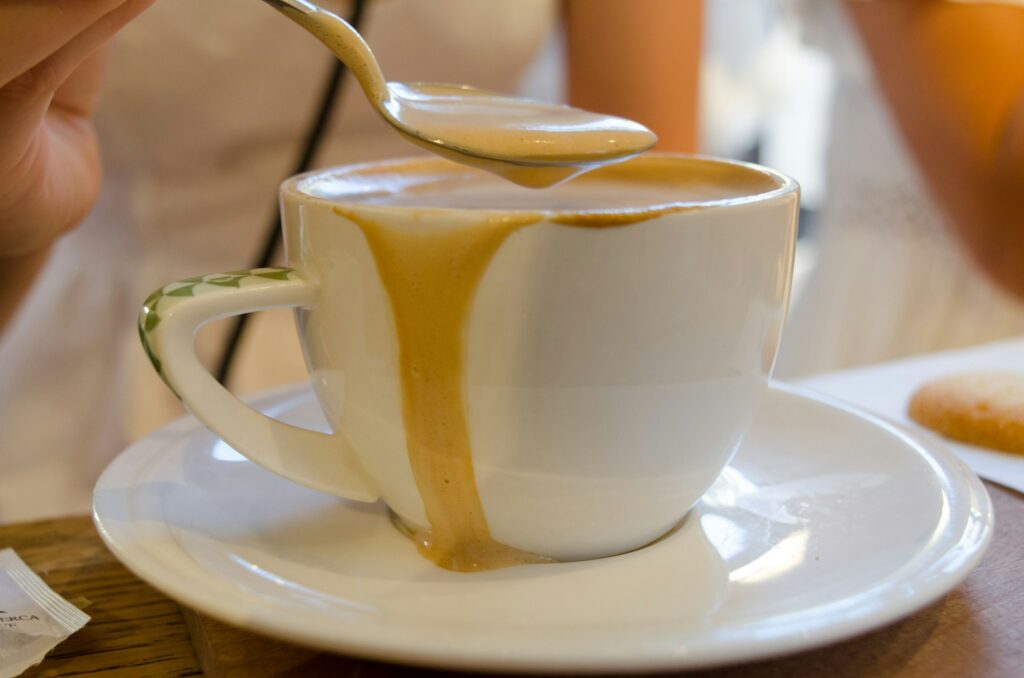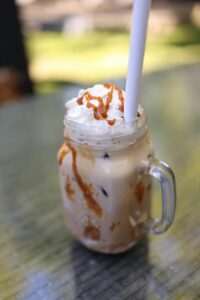Morning routines may look different across the globe, but coffee has a way of sneaking into almost all of them.
It’s the liquid alarm clock, the comfort in a cup, the ritual that turns sleepy mornings into something manageable.
What’s fascinating is how each culture prepares and enjoys it—sometimes quick and strong, sometimes sweet and slow, sometimes shared with friends, sometimes savored alone.
Coffee may be one drink, but the stories it tells are endless.
In this post, we’ll take a journey around the world to see how people greet the day with coffee and what those small daily rituals reveal about their lives!
Coffee as a Global Morning Ritual
There’s a reason coffee and mornings feel like lifelong partners in crime.
The caffeine kick sharpens focus, nudges the brain out of its fog, and gives that gentle push from “just five more minutes” to “alright, let’s do this.”
Beyond the science, though, there’s comfort in the ritual itself—the smell of freshly brewed coffee signals the day is officially starting, almost like flipping a switch from night to day.
For some, it’s productivity in a cup, a silent promise that the work ahead won’t feel quite as heavy.
For others, it’s a social ritual: the quick chat at the café, the shared pot at home, or the simple clink of mugs before heading out.
In many ways, coffee isn’t just a drink, but it’s a daily anchor that ties together energy, connection, and a sense of readiness for whatever the morning throws your way.
Europe’s Coffee Traditions
Italy: Espresso on the Go
In Italy, coffee isn’t just a drink; it’s a heartbeat of daily life. Mornings often begin in bustling cafés where regulars stand shoulder to shoulder at the counter.
They order an espresso, down it in one or two sips, and exchange a few quick words with the barista before heading off to work.
This ritual is less about lingering and more about efficiency—a concentrated burst of flavor and caffeine that matches the rhythm of Italian mornings.
The small, strong espresso also reflects a cultural preference for quality over quantity; Italians would rather savor one perfect shot than nurse a giant cup for an hour.
France: Café au Lait and Croissants
French mornings tell a different story. Here, coffee is woven into a slower, gentler start to the day.
A café au lait—a mix of strong brewed coffee and steamed milk—is usually served in a wide bowl rather than a mug, making it easy to dip a buttery croissant or slice of baguette right into the drink.
It’s breakfast as a sensory experience: warm bread, creamy coffee, and the unhurried pace of a French kitchen.
This ritual isn’t just about caffeine; it’s about savoring small pleasures and easing into the day with grace.
Sweden: The Social Pause of Fika
In Sweden, coffee becomes the centerpiece of connection through fika, a cultural tradition of slowing down to share coffee and conversation.
Even in the morning, before the day fully takes off, Swedes might gather with friends, family, or coworkers for a quick fika—often paired with cinnamon buns or pastries.
It’s a moment to step off the treadmill of life, check in with one another, and start the day grounded.
This ritual shows that for Swedes, coffee isn’t just a solo pick-me-up; it’s a social glue that holds relationships together.
Turkey: Strong and Symbolic
Turkey offers one of Europe’s oldest and richest coffee traditions. Turkish coffee is brewed slowly in a small pot called a cezve, often with sugar added during the brewing process.
The result is a thick, unfiltered coffee served in tiny cups, meant to be sipped rather than gulped.
Beyond the drink itself, Turkish coffee carries deep symbolism: it’s offered to guests as a sign of hospitality, used in pre-wedding rituals, and even read for fortunes from the grounds left behind.
In the morning, it’s not just caffeine in a cup but a practice that blends history, family, and a sense of ceremony into the start of the day.
The Americas
United States: Grab-and-Go Culture
In the U.S., coffee is often less of a sit-down ritual and more of a lifeline. Mornings are fueled by giant to-go cups from drive-thrus, office coffee pots, or personal drip machines.
For many Americans, coffee is about convenience and quantity—it’s the companion on a commute, the background hum of a meeting, or the “don’t talk to me yet” mug at home.
But there’s also a growing specialty scene, where morning pour-overs and lattes are savored with the same care you’d find in Europe.
In short, American coffee culture straddles two worlds: fast, functional fuel and an evolving appreciation for craft.
Brazil: The Everyday Cafézinho
In Brazil, mornings often begin with a cafézinho, a small, strong, and sweet black coffee. It’s poured generously, whether at home, in an office, or offered by a shopkeeper to welcome customers.
Coffee here is not just a drink but an act of hospitality, and the cafézinho embodies Brazilian warmth and openness.
Unlike the oversized American mug, the serving is small, but the impact is big—it sets the tone for connection and energy throughout the day.
Colombia: Tinto as Daily Life
Colombia, one of the world’s largest coffee producers, has its own humble morning staple: tinto.
This is a simple black coffee, often served lightly sweetened, and it’s everywhere—from street vendors to family kitchens.
Colombians don’t necessarily treat it as an indulgence but as an everyday necessity, woven into the rhythm of life.
A tinto in the morning isn’t just about waking up, but it’s about grounding yourself in routine, no matter how busy or simple the day ahead may be.
Asia and the Middle East
Japan: Convenience and Craft
In Japan, coffee culture straddles two extremes—ultra-fast convenience and meticulous craftsmanship.
On one side, there’s canned coffee, available from vending machines on nearly every corner, making it the go-to choice for commuters and early risers in a hurry.
On the other hand, there’s the slower, ritualistic art of pour-over brewing, often enjoyed at kissaten (traditional coffee houses) or specialty cafés.
Vietnam: Strong and Sweet
Vietnamese mornings often start with cà phê sữa đá—a bold coffee brewed through a small metal drip filter called a phin, then mixed with thick, sweetened condensed milk and served over ice.
The result is rich, sweet, and strong enough to jolt anyone awake. In northern regions, hot versions are common, while the south embraces the iced variety.
Either way, it’s not just about caffeine; it’s about pleasure and indulgence.
Coffee here is as much a treat as it is a wake-up call, often enjoyed slowly while reading the paper or catching up with friends.
Saudi Arabia and the Middle East: Coffee as Hospitality
In Saudi Arabia and across much of the Middle East, mornings can begin with gahwa—Arabic coffee flavored with cardamom and sometimes saffron.
It’s typically poured into small handle-less cups and served alongside dates. More than just a drink, it’s a symbol of welcome, respect, and hospitality.
Offering coffee is a gesture of generosity, and drinking it becomes a moment of connection.
Morning coffee here isn’t rushed; it’s steeped in tradition, reminding everyone at the table that relationships come first.
India: Frothy Filter Coffee
In South India, mornings are almost synonymous with filter coffee.
Brewed strongly using a traditional metal filter, then mixed with hot milk and sugar, it’s poured back and forth between a tumbler and a dabara (a small metal bowl) until it becomes frothy and aromatic.
The process itself is half the experience, filling the kitchen with sounds and smells that signal the start of the day.
For many families, filter coffee isn’t just fuel, but it’s heritage, comfort, and the heart of the morning routine.
Africa
Ethiopia: The Birthplace of Coffee
Ethiopia is often called the birthplace of coffee, and mornings here can still carry a ceremonial air.
In many households, the day begins with a traditional coffee ceremony that involves roasting green beans over an open flame, grinding them by hand, and brewing the coffee in a clay pot called a jebena.
The process is slow, intentional, and deeply communal—family members or neighbors gather to talk, laugh, and share stories while the coffee is prepared.
This isn’t just about caffeine; it’s about connection, spirituality, and honoring a tradition that stretches back centuries.
Even in modern Ethiopian cities, the ceremony remains a way to ground mornings in togetherness and cultural pride.
Morocco: Spiced and Slow
In Morocco, mornings often begin with coffee infused with spices like cinnamon, nutmeg, or cardamom.
Unlike the quick shot of espresso or the grab-and-go culture elsewhere, Moroccan coffee encourages a slower pace.
The fragrant spices turn a simple cup into a layered experience that warms more than just the body.
It’s common to enjoy this coffee at home before heading out, sometimes alongside fresh bread or pastries.
Much like Moroccan mint tea, spiced coffee is a ritual of hospitality and calm, which is a reminder to start the day with intention rather than haste.
Modern Trends Shaping Global Coffee Mornings
Specialty Coffee and the “Third Wave”
Across the world, mornings are being reshaped by the rise of specialty coffee. People are paying more attention to where beans come from, how they’re roasted, and the best way to brew them at home.
Pour-over kits, AeroPress devices, and precision grinders are no longer just for baristas as they’re on kitchen counters everywhere.
This shift has turned the morning cup from a mindless habit into a mindful ritual, where quality and craft matter as much as the caffeine.
Health-Driven Alternatives
Not everyone wants the jitters or the late-afternoon crash that coffee can bring, so new twists are popping up.
Decaf has been reinvented with better flavor, mushroom coffee is marketed as a brain booster, and butter-laced “bulletproof” coffee promises long-lasting energy without the crash.
For health-conscious coffee lovers, the morning cup has become a kind of functional drink—still comforting, but with a performance edge.
Global Influence and Fusion
Globalization has also blurred the lines between traditions.
A Japanese commuter might sip a latte, an American café might serve Turkish-style brews, and a Parisian might order a matcha latte instead of a café au lait.
Social media accelerates these exchanges, making it easy for people to try foreign styles in their own kitchens.
The result is a morning landscape where boundaries fade and creativity thrives—where coffee is less about sticking to one tradition and more about borrowing, mixing, and making it personal.
Final Words
Coffee is more than a pick-me-up. It’s a cultural handshake, a comfort blanket, and a spark that sets the day in motion.
Every country, every household, every cup tells a different story—about lifestyle, tradition, and the little rituals that make mornings bearable.
So next time you take that first sip, pause for a second. Somewhere across the world, millions of others are doing the same, each cup carrying its own meaning.



